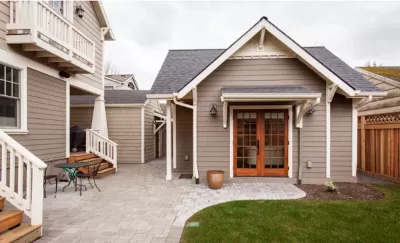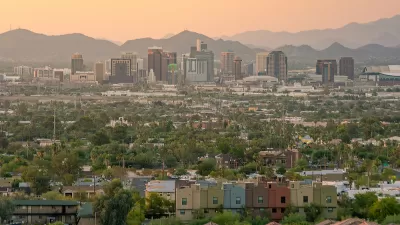A provision in the city’s ADU ordinance allows developers to build an essentially unlimited number of units on single-family lots.

Developers in San Diego are using the city’s ADU Bonus Program to build multi-unit accessory dwelling units (ADUs) that go far beyond the typical ‘granny flat,’ reports Ben Christopher in CALmatters. “The city’s one-of-a-kind ordinance offers landlords a one-for-one deal. If they agree to construct an ADU and keep the rent low enough for San Diegans making under a certain income, they’re automatically permitted to build a second ‘bonus’ unit, which they can rent at whatever price they like.”
The law generally allows for up to five units on one property. “But in bus-and train-adjacent ‘transit priority’ areas — a designation that covers much of San Diego’s urban core — a landlord can alternate affordable and bonus units again and again and again.” Although there are height and floor area ratio limits, “you can squeeze in an awful lot of ADUs within those parameters.” In one case, a single lot now holds nine apartment units, of which four are ADUs. According to the city, a typical ADU application includes 4 to 7 units, while the largest project with a submitted application is 148 units.
As Christopher explains, “Depending on your perspective, San Diego’s ‘crafty little maneuver’ is either an ingeniously clever use of state law to provide a much needed boost to the local housing supply or a sneak effort to foist an intolerable degree of construction and density upon unsuspecting residents while only providing a token degree of affordability.”
FULL STORY: Not your grandma’s granny flat: How San Diego hacked state housing law to build ADU ‘apartment buildings’

Study: Maui’s Plan to Convert Vacation Rentals to Long-Term Housing Could Cause Nearly $1 Billion Economic Loss
The plan would reduce visitor accommodation by 25,% resulting in 1,900 jobs lost.

North Texas Transit Leaders Tout Benefits of TOD for Growing Region
At a summit focused on transit-oriented development, policymakers discussed how North Texas’ expanded light rail system can serve as a tool for economic growth.

Why Should We Subsidize Public Transportation?
Many public transit agencies face financial stress due to rising costs, declining fare revenue, and declining subsidies. Transit advocates must provide a strong business case for increasing public transit funding.

How to Make US Trains Faster
Changes to boarding platforms and a switch to electric trains could improve U.S. passenger rail service without the added cost of high-speed rail.

Columbia’s Revitalized ‘Loop’ Is a Hub for Local Entrepreneurs
A focus on small businesses is helping a commercial corridor in Columbia, Missouri thrive.

Invasive Insect Threatens Minnesota’s Ash Forests
The Emerald Ash Borer is a rapidly spreading invasive pest threatening Minnesota’s ash trees, and homeowners are encouraged to plant diverse replacement species, avoid moving ash firewood, and monitor for signs of infestation.
Urban Design for Planners 1: Software Tools
This six-course series explores essential urban design concepts using open source software and equips planners with the tools they need to participate fully in the urban design process.
Planning for Universal Design
Learn the tools for implementing Universal Design in planning regulations.
City of Santa Clarita
Ascent Environmental
Institute for Housing and Urban Development Studies (IHS)
City of Grandview
Harvard GSD Executive Education
Toledo-Lucas County Plan Commissions
Salt Lake City
NYU Wagner Graduate School of Public Service





























